2012 VOLKSWAGEN GOLF PLUS brake
[x] Cancel search: brakePage 154 of 541

Never drive fa ster than mph mph -
Never try to stop the swaying by accelerating.
fir st read a nd note the imroductory informatio n and heed the on page
If the ve hicle was fac tory-equipped with a trail er
hi tch, all technical and lega l require m em s fo r
trailer towi ng have already been m et.
use a trai le r hitc h w hich is approve d for the
g ro ss wei ght rating of the trailer yo u want to tow. The hit ch mus t be s uitabl e fo r your vehicle and
tr ailer and be securely bolt ed to the ve hicle's chassis. use a trail er hitc h with a re movable ball mount. Alway s check and follow the trail er
hi tch manufacturer's information. Neve r in stall a o r tra ile r hitch on yo u r vehicle.
D o n
ot use a bumper-mounted trai le r h itch
Never insta
ll a trailer hitch on the bumper o r or on th e bumper mountings. The traile r hit ch mus t not in terfe re wit h the impact-absorbing bumper syste m . D o not make any changes to the ve hicl e exhaust and brake sys te m s. From time to time, check that all hitch m oumin g bolts are securely fas ten ed . W hen not towing. re m ove the trailer hi tch. Thi s help s ke ep the hitch from causin g damage if your ve hicl e is hit from behind.
Eng ine cooling syste m
Tow ing a tra
iler makes the e ngin e
If you arc dri ving a new ve hicle or ave-do not tow
a t railer
mil es
need
load it h as to pull.
When you are not towin g, remove the trailer
models need trail er hit ch to tow or tow -s tart other ve hicl es. may
Trailer brakes
If your trail er has its own brake s, make sure it
meet s all regulati ons. Th e trailer bmke sys te m
mu st never be directly connecte d to the ve hicle's brake system .
Safety c
hain s
A lways u
se safety chains be tween yo ur vehicle and
th e trailer.
Trail er rear lights
Tra
ile r lights must meet all regulation s.
Neve r
connect the tmil er l ights directly to the e lec
trica l s ys tem of your ve hicl e. Be su re to check wit h
your authorized Volkswagen dealer or authorized Volk swagen Faci lit y about correct w iring, sw itches and re lay s.
Outside mirrors
I f
the s ta ndard ou ts id e mirror, addition al outs ide m irrors are needed and required b y law in so me coumrie s I states I provin ces. The o uts id e
mirr o rs mus t b e adjuste d b efore driv in g and g ive good v iew to the rear.
Max im um power consump tio n f or th e trailer
D o no t excee d the power ratin gs liste d in the chart below.
E l
ectrical consumers power con-sumptio n
Taillight s
Turn signals pe r sid e 54 wat ts
Page 155 of 541
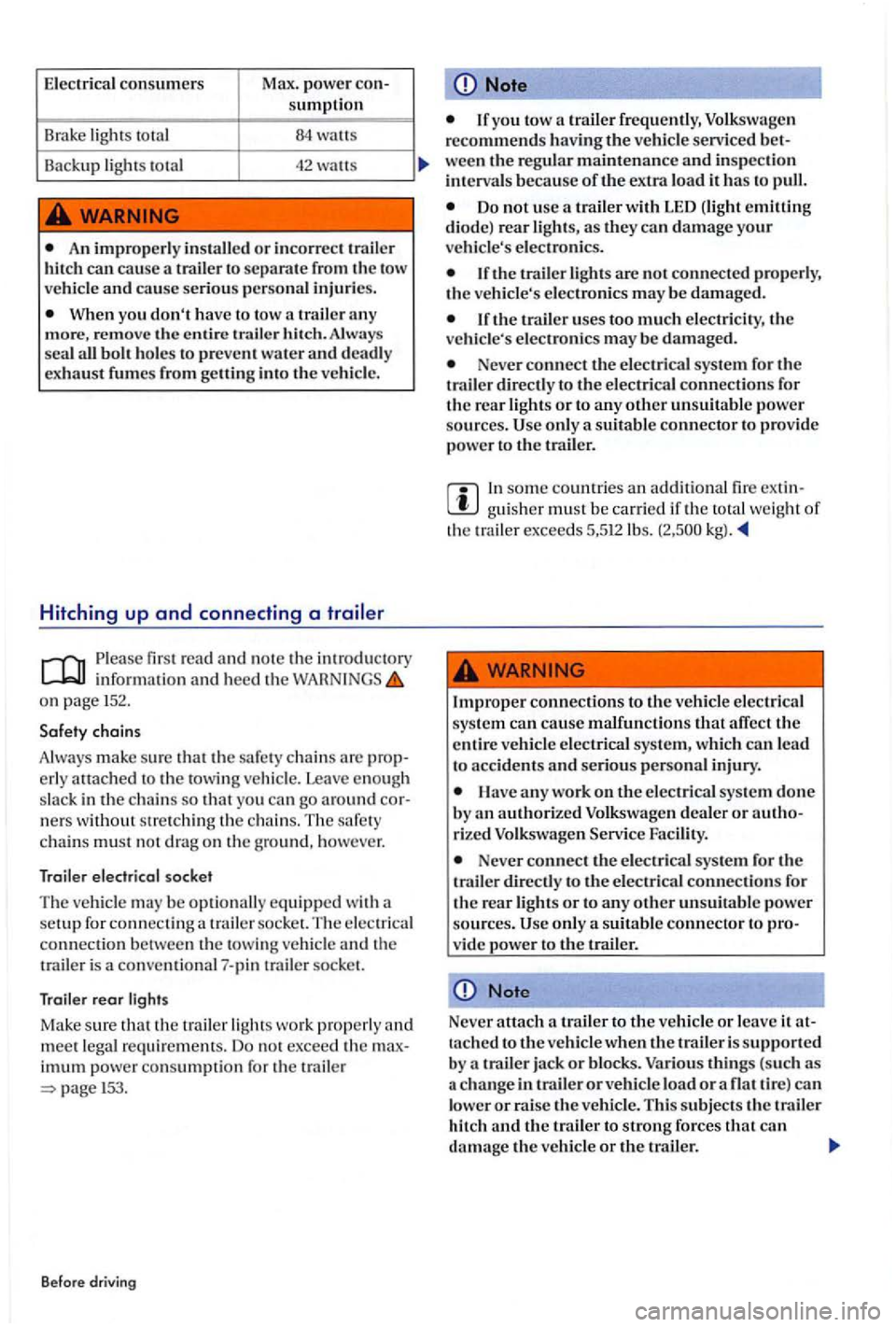
Electrical consumers Max. power sumption
Brake lights total
An improp erl y in sta ll ed or incorrect t railer hit ch can
trail er any
m ore , remove the entire trailer hitch. Always
sea l all bolt ho les to prevent water and deadly
exhaust fumes from getting int o the ve hicle.
Hitching up and connecting a
Ple a se firs t r ea d and no te the introdu cto ry informati on and heed th e on pag e 152.
n ers witho ut str etc hi ng the c hain s. T he safety
c hain s mu st n ot drag o n th e g ro und, ho wev er.
Trailer electrical socket
The vehicl e m ay be opti onally equipped with a
setup for con nec ting a trailer so cket. Th e ele ctrical connec tio n betwee n th e towing ve hicle and the
trailer is a convent io nal7-pin trailer socke t.
T raile r rear lights
Mak e sure that th e trailer light s work prop erly and
m ee t le gal re quir em ent s. D o no t excee d th e
im um po w er co nsumpti on f or th e trail er 153 .
Before drivin g
Note
If you tow a trailerfrequenll y,
ween th e re gular maintenance and inspecti on
int erva ls because of the extra load it has to pull.
Do not use a trailer with LED (lig ht emitting
di ode) rear lights, as they ca n d amage your ve hicle's ele ctroni cs.
If the uses too much elec tricity, the
ve hicle' s e lectroni cs may be damaged.
Never connect the electric.1.l system for th e
trailer directly to the electrical connection s for
th e rear light s or to any other unsuitabl e powe r
sources. Use onl y a suit abl e connector to provide
po we r to trailer.
In some co untries an additio na l fire extingui sh er must be carried if th e tota l w eight of th e trailer exce e d s 5,512lb s.
Improp er connections to the ve hicl e elec trical
sys te m can cause malfunction s that affect the
entire vehicle electrical system, which lead to acciden ts and seriou s pe rso nal injury.
Have any work on the electrical syste m d on e
b y an authorized Volkswage n dealer or autho
rized Volk sw age n Facility.
Never connect th e e lectrical syste m for the trailer to Ll1e e lectrical connections for
th e rear lights or to any other unsuit abl e power
sources . Usc only a suitabl e con nec tor to vide power to the trail er .
Note
------------------------~ Never attach trailer to the vehicle or leave it taclled to the vehicle when the trail er i s supported
b y a trailer jack or blocks. Various thin gs (sucl1 as c h a ng e in traile r or vehicl e load or a fla t tir e) can lower or raise the ve hicle. Thi s subj ects th e trailer
hit ch and th e trailer to strong fo rces that can d a mag e th e ve hicl e or the trailer.
Page 157 of 541
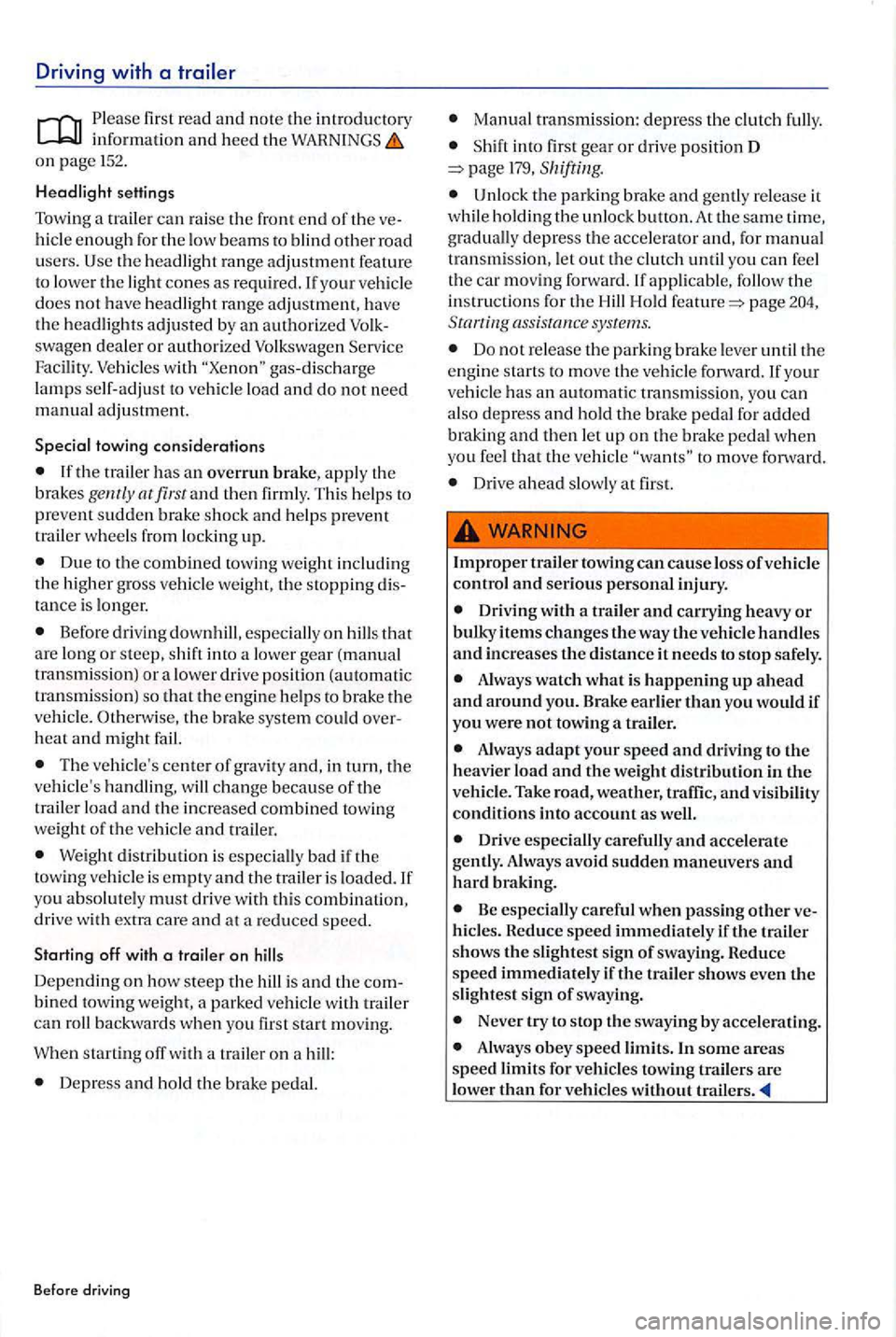
Driving with a
Please fir st read and note the introductory
o n page 152.
Headlight settings
Towing a tra
ile r can ra ise the fron t end of th e ve
hicle enough fo r the low beam s to blind other road u sers. the headlight ra nge adjustment feature
to lower the light cones as req uired . your vehicle does not have headlight range adjustment, have
the headli gh ts adjusted by an authorized Volkswage n dealer or au th orized Volkswagen Serv ice Facility . Vehicles with gas-d ischa rge lamps self-adjus t to vehicle load an d do not need manual adjustme nt.
Special towing
considerations
Due to th e combined towing weig h t includin g the hi gh er gross vehicle weight, the stopping distance is longer .
Before driving downhill , especially on hills that
a re long or steep, shift in to a lower gea r (m anual
t ransmi ssion) or a lower drive position (automatic
t ra n smi ssion) so that the eng in e helps to brake th e vehicl e. Otherwise, the b rake system could ove rheat and might fail.
The ve hicle's center of grav ity and, i n
Weigh t dis tr ibutio n i s especially bad if the
tow ing veh icle is e mpty and the traile r i s loaded. If
you absolutely must d rive with this combination , drive with extra care an d at a reduced speed.
Starting off with a trail er on hills
Depend ing o n how steep the h ill is and the combined tow ing weig ht, a parked vehicle wi th trailer can roll backwards when yo u firs t sta rt mov ing.
When sta rti
ng off with a trailer on a hill :
Depress and ho ld the brake pedal.
Befo re driv ing
Ma nual transmiss io n : d epress th e clutch fully.
Shift into fir s t gear or drive posi t ion D page 179,
Unlock the par ki ng brake and release it
w hil e ho ld ing th e unl ock butto n.
page assistance systems.
Do not re lease th e parkin g bra ke leve r until the engine sta rt s to move th e vehicle fonvard. your veh icle has an automatic t ransmissio n, yo u can
also depress a nd ho ld the brake pedal for added b raking and then letup on th e brake pedal w hen
you feel th a t the vehicle to move fo rward.
Drive ahead slowly at first.
A lways watch what i s happening up a head
and a round you. Brake earlier than you would if yo u were not to wing a trailer.
Drive especially care full y and accel erate gently. Always avoid sudde n m an euvers and h ard braking.
Be especiall y care ful when p ass ing other hicles. Reduce speed immediate ly if t he trailer
s hows the s lightes t sig n of swayin g. Reduce speed immediatel y if the t ra ile r shows even the
slightest sig n of sway ing.
Neve r try to sto p th e swayin g by accelerating.
Page 173 of 541
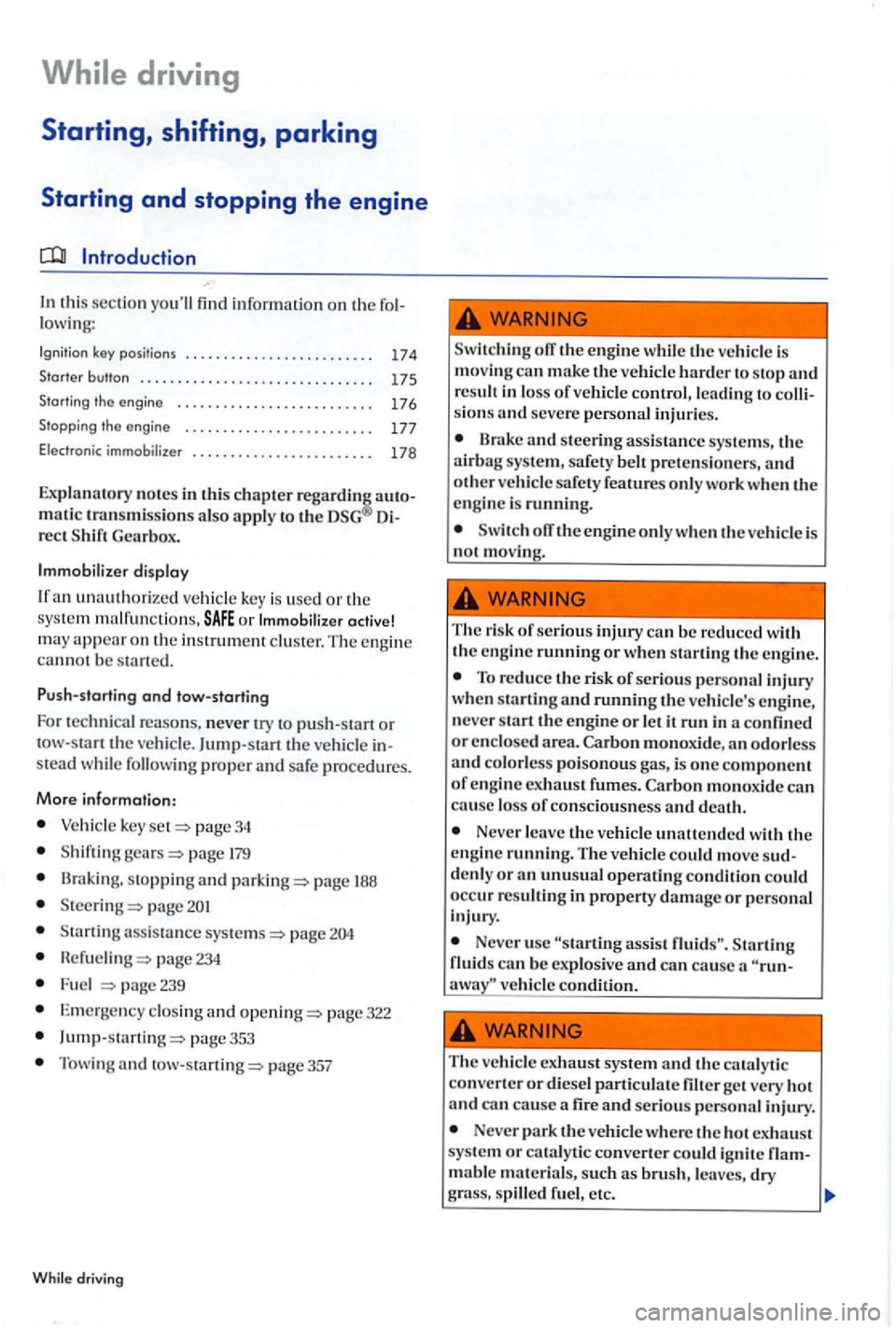
In this section yo u'll fin d information on th e
ke y p ositions . . . . . . . . . . . . . . . . . . . . . . . . 17 4
Starter button . . . . . . . . . . . . . . . . . . . . . . . . . . . . . . 175
Sta rting the engine . . . . . . . . . . . . . . . . . . . . . . . . . 176
S topping th e e ngine . . . . . . . . . . . . . . . . . . . . . . . . . 177
Electro nic immobi lizer . . . . . . . . . . . . . . . . . . . . . . . . 178
Explanatory no tes in thi s chapter regard
rec t S hift Gea rbox.
Immob i
lizer display
I f a n unauthori z
ed vehicle ke y is used or the
s y s te m malf un ctions, o r Immobiliz er activ e!
m ay appear on th e in strum ent cluster. The e ng in e cannot b e s tarte d.
P ush -starting
and tow-starting
F o r t ec hni cal re as
ons, never try to pus h -s ta rt or
stead w hil e following proper a nd safe proc edures.
Mor e information:
Vehicle key pag e 34
Shifting pag e
B raking, sto pping and page
pag e
234
Fuel page 23 9
E m erge ncy clo sing and page 322
353
Towing and page 357
W hile driv ing
Switch in g off the engin e whil e th e ve hicle is
m oving can m ake the ve hicl e harder to s top and re sult in loss of ve hicl e control,lcading to sion s and seve re personal injuri es.
Brake and steerin g assis ta n ce sys tem s, the
a irbag syste m, safety belt pretensione rs, and oth er vehicle safety features onl y wor k when the
e n gi ne is runni n g.
Sw itch off theengineon lyw he n th e vehicl e is
not m ov ing.
The ris k of serious injury ca n be reduced with
the e n g in e runnin g or when startin g the en gine .
To reduce th e risk of seriou s perso nal inju ry
w hen sta rling and running the ve hicle's en gi ne,
n eve r start the e ngine or le t it run in a confined or en clo se d area. Carbon an odorl ess and colorless poisonous gas, is one co mpone nt of en gine exhaust fumes . monoxide can cause loss of conscio usn ess and d ea th.
Never leave the ve hicle unattended with the
e ngin e running. Th e ve hicl e could move denly or a n unusu al operating condition could
occ ur res ult ing in property damage or personal
i njury.
Neve r usc assi st
The ve hicle exhau st s ys tem and th e ca ta ly tic
co nve rter or diese l particula te filter ge t very ho t
and ca n cause and seriou s perso nal injury .
Never park th e veh icle where the ho t ex haust
sys te m or cataly tic co nverte r could ignit e mable materials, su ch brus h , leaves, dry grass, spilled fuel, etc.
Page 178 of 541
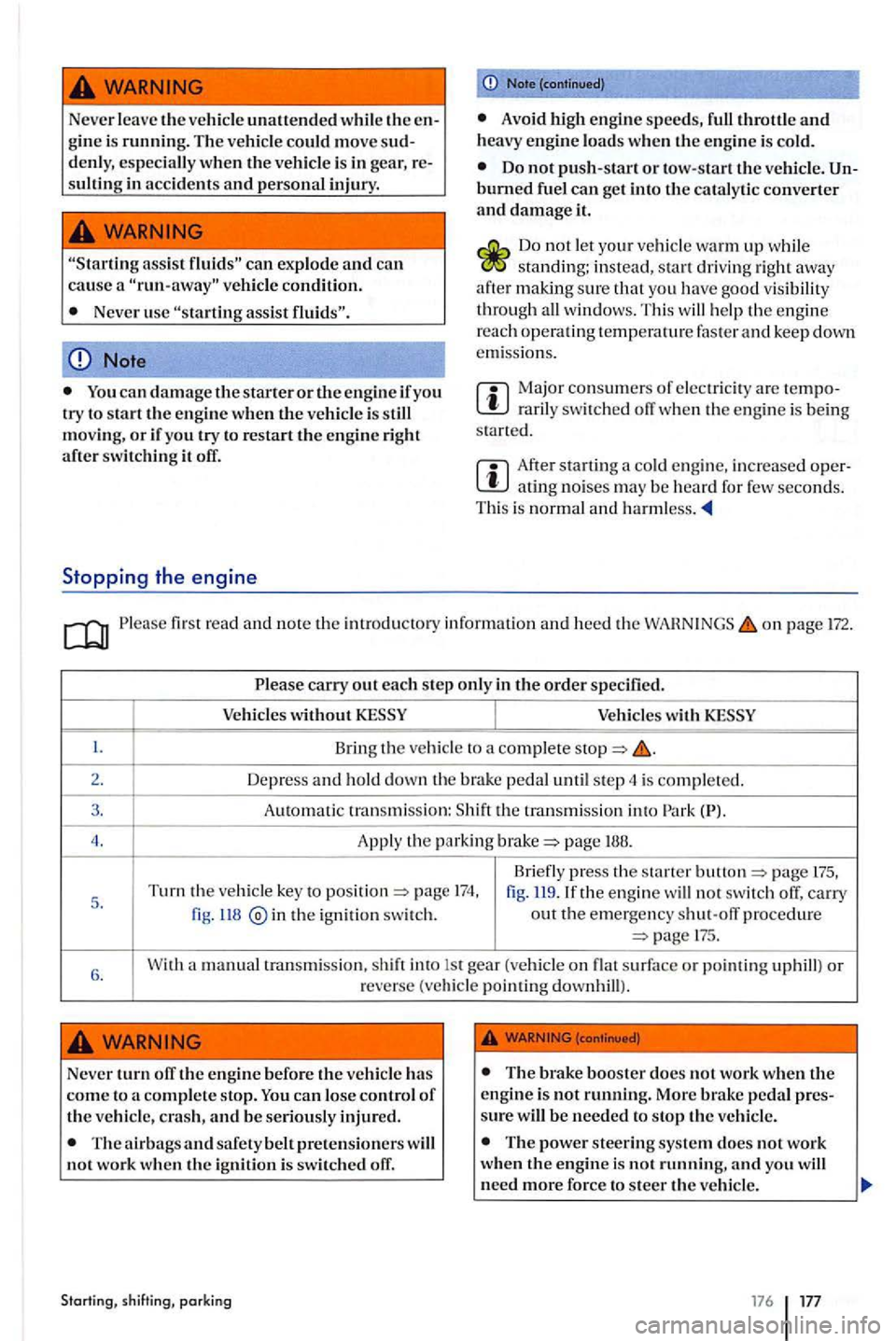
Never leave the vehicl e unattend ed w hil e th e e ngin e is running . The ve hicle could move sud
d enl y, es peci ally w hen th e vehicl e is in gear, re
s ultin g in accide nts and personal injury.
assis t ca n ex plode and ca n
ca use a ve hicle condition.
Neve r u se
Note
Yo u can damage the s tarter o r vehicl e is still
mo vin g, or if you try to res ta rt
Not e (c onti nued)
Avoid high en gin e sp ee ds, full throttl e and heavy en gin e lo ads wh en th e eng in e is cold.
D o n ot push-sta rt or tow-start the ve hicl e. Un
burne d fuel can ge t int o the cataly tic convert er
and damag e it.
Do not let yo ur vehicle warm up whil e sta nding; ins tead, sta rt driving right away
after makin g sure th at you have good vis ibil ity
t hrou g h all windows. This will he lp th e e ngin e
reach operating temperature fas ter an d keep down
emiss io ns.
Majo r consu mers of e lectricity are te mporarily swi tc hed off when th e e ng in e is bei ng
s tarted .
After starting cold engin e, increased operating nois es may be heard f or f ew seconds.
Thi s is no rmal and
firs t r ead an d note th e intro ductory in fo rm atio n an d heed th e page 172.
Pl
ease car ry out each ste p onl y in the order sp ecified .
Vehicl es with out
Bring th e veh icle to a co mplete
2. Depress an d hold down th e brake pedal until step 4 i s co mpleted.
3 . A uto matic tra nsm ission: Shif t the tra nsmiss io n in to Park (P).
4 .
Apply the parking page
pag e 175,
5. Turn th e vehicle key to pag e fig. 119. th e ignitio n sw itch. out the emergency sh ut -offproc edure
6. W ith a manual tra nsmiss ion, sh ift in to Ist gear (vehicle on fla t surfa ce or p ointing uphill ) or reve rse (vehicle pointing downhill ).
N ever turn off the e ngin e before th e ve hicle has come to
T he a irbags and safe ty belt prete nsio ners w ill not work when th e ig nition is swit ch ed off .
Starting, parking 176 177
Page 180 of 541
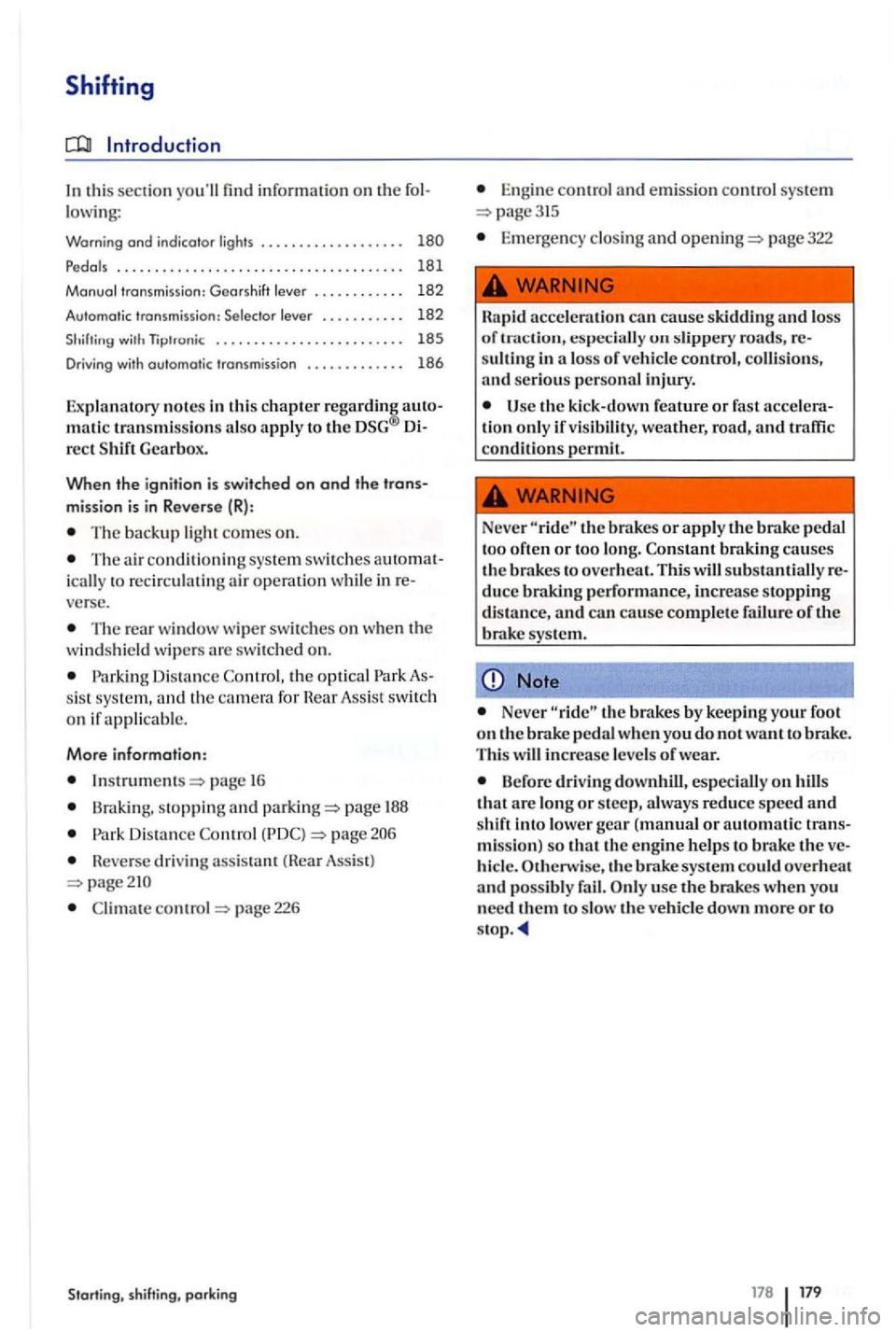
Shifting
Introduction
In this section you'll find information on
. . . . . . . .
Pedals . . . . . . . . . . . . . . . . . . . . . . . . . . . . . . . . . . . . . . 181
Manual transmi ssion: Gearshift lever . . . . . . . . . . . . 182
Automa tic transmission: Selector lever . . . . . . . . . . . 182
with Tiptronic . . . . . . . . . . . . . . . . . . . . . . . . . 185
Driving with automatic transmission . . . . . . . . . . . . . 186
E xplanatory no tes in thi s chapter also apply rect Gearbox.
When the ignition is switched on and th e
T he backup light comes on.
Th e air co nd itionin g sys te m sw itch es ically r ecirculat ing air verse.
The rear window wiper swi tches on when
sis t sys te m , a nd camera For
Instrum em s
Brak ing, and
D is tance
H everse driving assista nl (Rea r Assist)
Clima te comrol
Eng in e contro l and emission cont rol sys tem
Eme rgen cy closi ng and page 322
accelera tion can cause skidding and loss of t ract ion, especially on slipp ery roads, sulling in loss of vehicl e control , collision s,
and seriou s personal injury.
kick -d own feature or fast ti on onl y if vis ibility, weather, road , and traffi c
co nditi ons permit.
Neve r
or apply the p edal often or lo ng. Constant brakin g ca uses the brakes to over hea t. This subs ta nti ally duce performance, increase stop1> ing
d is tance, and cau se complete failure of th e
Note
Neve r the brakes by keeping your foot
o n brake ped al when you do not want to brake.
Thi s
Before driving downhill , es peci all y on that are lon g or steep, alw ays reduce speed an d into lower gear (manual or auto mati c mission) so that th e engin e help s to brake hi cle. Otherwi se, th e brake system could over hea t and possibl y fail. use th e when yo u
n eed them slow v ehicl e dow n more or
Page 181 of 541
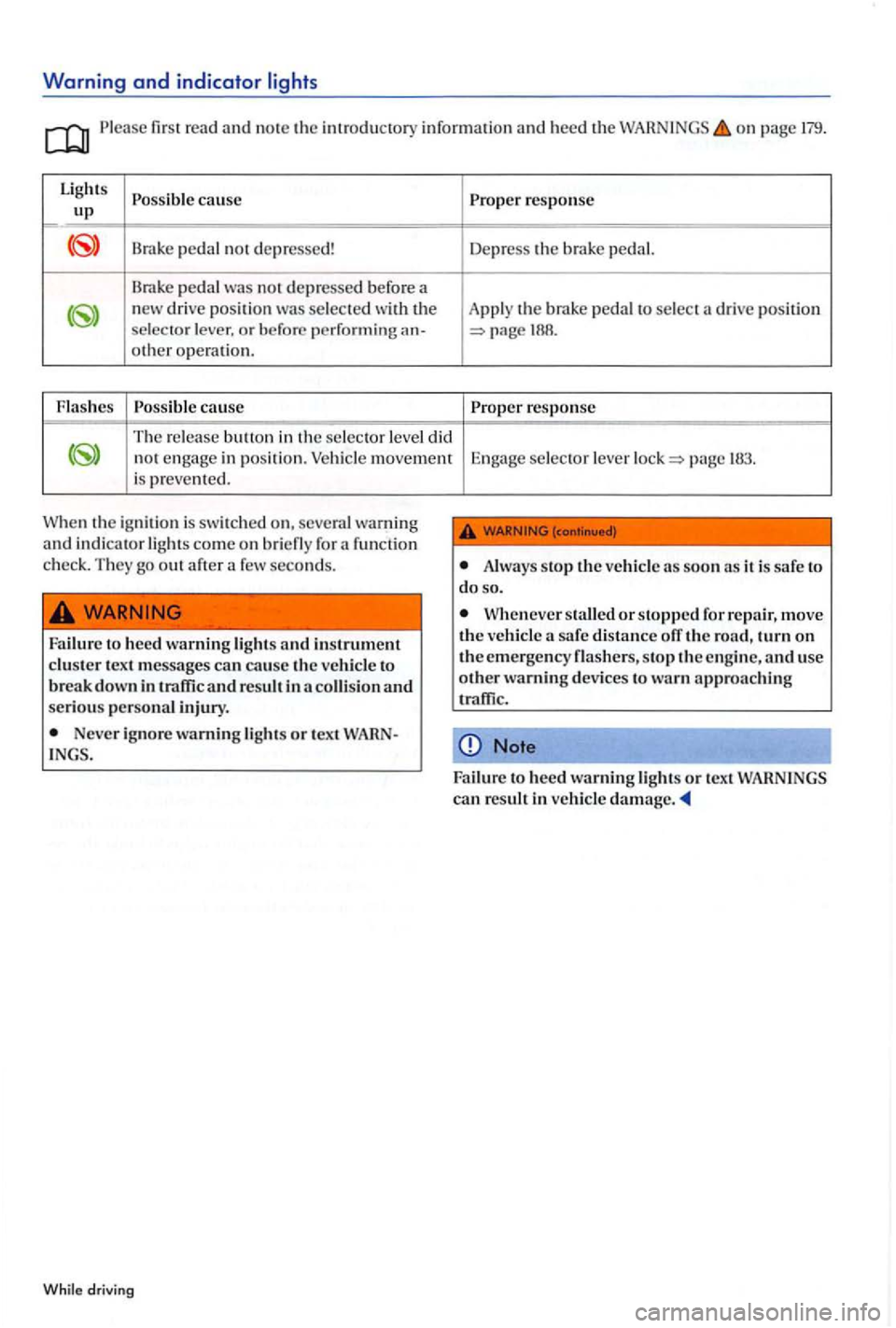
Warning and indicator
Please fir st r ead and not e th e int rod uc tory informatio n and heed th e on pag e 179.
Light s
Possibl e cause up
Brak e pedal not d ep ressed!
Brake pedal w as not depressed before a new drive position wa s selected with the
se lec to r l eve r. o r be fo re pe rformin g
Possibl e caus e
The re lease bul!on in th e s elec tor leve l did
n o t en gage in po siti on. V ehicle is preve nted.
th e ig niti on i s s witch ed on, seve ral warnin g
and indica to r lig hts c om e on briefly fo r a function
c heck . T hey go out aft er few sec o nd s.
to hee d warning light s and in strument
clu ste r te xt m essages cause the v ehicl e to
b reak d own in and result in colli sion and seri ou s persona l injury.
Neve r ignore warning lig ht .s or t ext
drivin g
Prop er re sponse
Dep ress the brake pedal.
Appl y th e brake pedal to sele ct a dri ve position
Prop er re sp o nse
E ngage se lecto r lev er
page 183.
Alwa ys stop the ve hicl e as s oo n it is safe to
d o s o.
stalled or stopped f or r epa ir , move the ve hicl e a safe di sta n ce
Note
Fa ilur e to heed warning lights o r tex t
Page 182 of 541
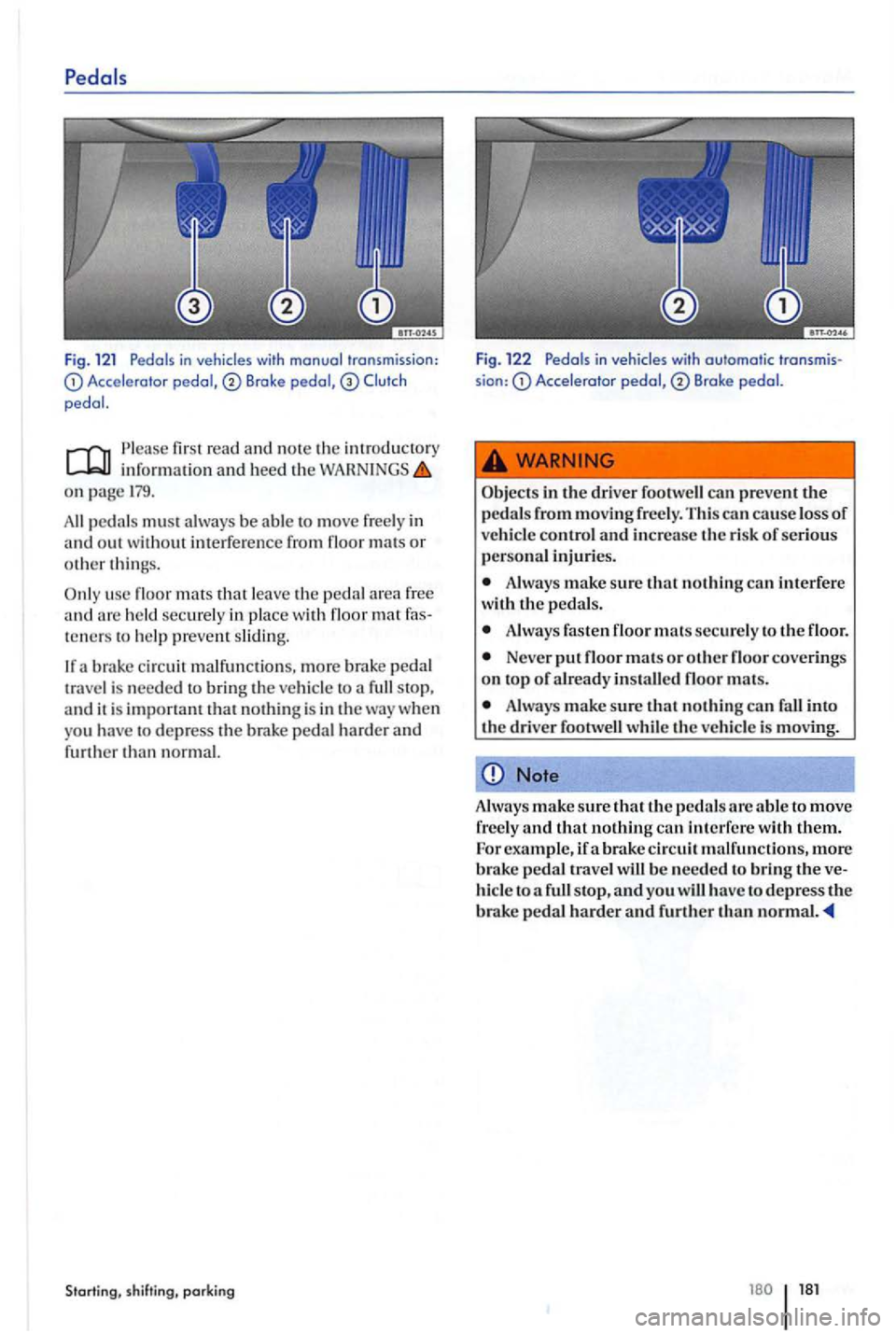
with manual transmission: Clu tch
Plea se first re ad and note th e in troducto ry information and heed th e on pag e
usc floor mats that leave the pedal area fre e and ar e held sec urel y in plac e w ith floor mat fas
t e n ers to help prevent slidin g.
with automatic transmis
s io n : Accelerator pedal, Broke
in the driver footwell can prevent the pedal s from moving fr ee ly . Thi s ca n ca use loss of vehicl e control and increase the risk of serious
p ersonal injurie s.
Never put floor mats or other floor coverings
o n top of alr eady in stalled floor mats.
Always make sure that n o thing can f all into
th e driver footwell while the vehicl e is mov ing.
CD Note
Alway s make sure that the pedals arc abl e to move
fre ely and that nothing ca n interf ere with them.
For examp le, if a brak e ci rcui t malfun ction s, more brake pedal trave l will be needed to bring the ve
hicl e to a full stop, and yo u will have to depress th e
brake pedal harde r and further than